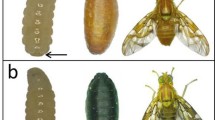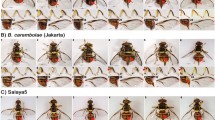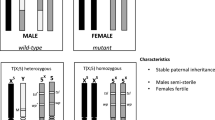Abstract
Over the last 10 years, several genetic sexing strains have been isolated for the Mediterranean fruit fly, Ceratitis capitata, with the aim of improving the Sterile Insect Technique. However, a major problem with the currently used genetic sexing system, which is based on translocations, is their potential genetic instability. Therefore, careful monitoring and chromosome analyses are necessary when new genetic sexing strains are developed. Instability of a genetic sexing strain can be the consequence of recombination or the survival of aneuploid individuals occurring as a consequence of adjacent-1 segregation in the meiosis of males with Y-autosome translocations. Recently, genetic sexing strains have been isolated that show only low levels of recombination. However, many aneuploid flies are produced by these strains. Therefore, we have made an attempt to isolate new genetic sexing strains that show a low percentage of recombination and no survival of aneuploid individuals. We report their genetic behaviour and the polytene chromosome structure of these new strains.
Similar content being viewed by others
References
Ashburner M (1989) Drosophila. A laboratory handbook. Cold Spring Harbor Laboratory Press, Cold Spring Harbour, N.Y.
Bedo DG (1986) Polytene and mitotic chromosome analysis in Ceratitis capitata (Diptera: Tephritidae). Can J Genet Cytol. 28:180–188
Bedo DG (1987) Polytene chromosome mapping in Ceratitis capitata (Diptera: Tephritidae). Genome 29:598–611
Foster GG, Vogt WG, Woodburn TL (1985) Genetic analysis of field trials of sex-linked translocation strains for genetic control of the Australian sheep blowfly Lucilia cuprina (Wiedemann). Aust J Biol Sci 38:275–293
Franz G, Kerremans Ph (1993) Radiation induced chromosome aberrations for the genetic analysis and manipulation of the Mediterranean fruit fly, Ceratitis capitata. In Proc Int Symp Management Insect Pests Nuclear Related Mol Genet Technique. IAEA, Vienna, Austria, pp 187–194
Franz G, Kerremans Ph (1994) Requirements and strategies for the development of genetic sex separation systems with special reference to the Mediterranean fruit fly Ceratitis capitata. In: Calkins CO, Klassen W, Liedo P (eds) Fruit flies and the sterile insect technique (Proc 19th Int Cong Entomol). CRC Press, Florida, pp 113–122
Franz G, Genscheva E, Kerremans Ph (1994) Improved stability of genetic sex-separation strains for the Mediterranean fruit fly, Ceratitis capitata. Genome 37:72–82
Kerremans Ph, Franz G (1994) Cytogenetic analysis of chromosome 5 from the Mediterranean fruit fly, Ceratitis capitata. Chromosoma 103:142–146
Kerremans Ph, Bourtzis K, Zacharopoulou A (1990) Cytogenetic analysis of three genetic sexing strains of Ceratitis capitata. Theor Appl Genet 80: 177–182
Kerremans Ph, Genscheva E, Franz G (1992) Genetic and Cytogenetic analysis of Y-autosome translocations in the Mediterranean fruit fly, Ceratitis capitata. Genome 35:264–272
Robinson AS, Van Heemert C (1982) Ceratitis capitata — a suitable case for genetic sexing. Genetica 58:23–24
Robinson AS, Cirio U, Hooper GHS, Capparella M (1986) Field cage tudies with a genetic sexing strain in the Mediterranean fruit fly, Ceratitis capitata. Entomol Exp Appl 41:231–235
Rössler Y (1979) Automated sexing of Ceratitis capitata (Diptera:Tephritidae): the development of strains with inherited, sexlinked pupal color-dimorphism. Entomophaga 24:411–416
Rössler Y, Koltin Y (1976) The genetics of the Mediterranean fruit fly, Ceratitis capitata: three morphological mutations. Ann Entomol Soc Am 69:604–608
Rössler Y, Rosenthal H (1988) Genetics of the Mediterranean fruit fly (Diptera: Tephritidae): Eye color, eye shape and wing mutations. Ann Entomol Soc Am 81:350–355
Rössler Y, Rosenthal H (1992) Genetics of the Mediterranean fruit fly (Diptera: Tephritidae): morphological mutants on chromosome five. Ann Entomol Soc Am 85:525–531
Whitten MJ, Foster GG (1975) Genetic methods of pest control. Annu Rev Entomol 20:461–476
Whitten MJ, Foster GG, Vogt WG, Kitching RL, Woodburn TL, Konovalov C (1977) Current status of genetic control of the Australian sheep blowfly, Lucilia cuprina (Wiedemann) (Diptera: Calliphoridae). In: Foster et al. Theor Appl Genet (1991) 82:681–689, Proc 15th Int Cong Entomol., Washington, D.C., pp 129–139
Author information
Authors and Affiliations
Additional information
Communicated by J. S. F. Barker
Rights and permissions
About this article
Cite this article
Kerremans, P., Franz, G. Isolation and cytogenetic analyses of genetic sexing strains for the medfly, Ceratitis capitata . Theoret. Appl. Genetics 91, 255–261 (1995). https://doi.org/10.1007/BF00220886
Received:
Accepted:
Issue Date:
DOI: https://doi.org/10.1007/BF00220886




